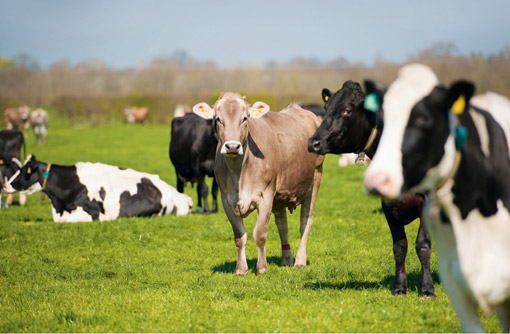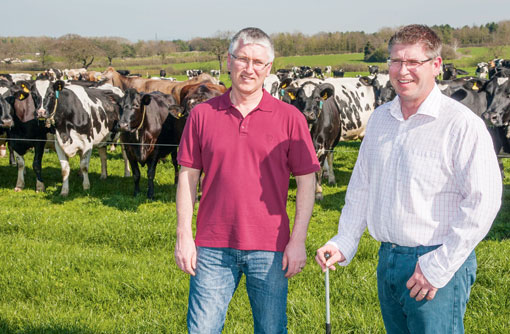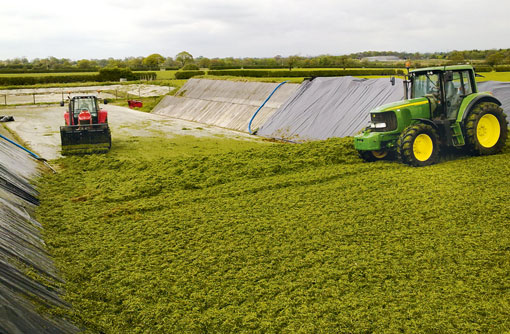Grassland management pays its way

Addressing grassland management and the way cows are fed at Park Hall Farm, Cheshire, has helped achieve 4,000 litres a cow a year from forage out of an overall average of 8,000 litres a cow a year – all from 2.1t of concentrate a cow.
The last three to four years have seen some big changes in the way the 260-cow herd is run by brothers John and Phil Riley – most notably a shift away from all year round calving towards a late-summer block, while pushing to achieve more milk from forage.
Feeding
John explains that in the past, when the herd was calving all year round, stock had received a buffer throughout the season and were not fed in the parlour. Consequently, cows at various stages in their lactation were receiving the same ration.
“In September 2009 we were doing 8,300 litres off 3.1t of cake with 2,200 litres from forage. The most we would get off forage would be 2,500 litres. At the time we wanted to cut concentrate and get more from forage, but we needed to ensure grass was managed correctly to do so.”
As a result, in-parlour feeders were installed to feed cows to yield. At the time, cows were being paddock grazed for the first time as two groups of high and low yielders, but this created challenges, says Phil. “It was difficult, as you almost needed two systems to get two paddocks at the same stage,” he explains.

Cows are now grazed as one group in a paddock and no longer receive any type of buffer while out at grass. Now the herd is yielding slightly less, but with more from forage and less concentrate use.
“We’ve almost gone full circle – we’ve put the paddocks up that dad had in 20 years ago and the in-parlour feeders have gone back in.”
At a cost of £50,000 to install the feeders and individual cow milk meters, it has been expensive to make the changes. However, the benefits have been numerous, according to the brothers.
“There’s less scraping as we only have to do the collecting yard, milking times are reduced as we don’t have the milking preparation and we’re also not feeding silage during the summer so we’re not using the tractor, loader or feeder wagon.
“It is also very difficult to graze cows when feeding silage, so removing the buffer helps train them and make them more willing to graze,” says Phil.
| Getting more from forage at Park Hall Farm |
|---|
|
Grazing set-up
An outline of the current grazing set-up is as follows:
- The farm is split as best as possible, with most paddocks at 2ha (5ac) – these are divided according to group size and cover which is established through weekly grass plate metering.
- During the main grazing season, they aim to achieve grazing residuals of 1,500-1,600kg DM/ha with stock going in at 2,800kg DM/ha.
- At the height of grazing, the farm aims for 14-16kg dry matter intakes a cow a day from grazed grass.
Generally we have good covers here – it never stops growing, which is why we needed to get more from it. Ultimately, grass grows grass – when you graze tight enough it will grow back, explains John.
“And it’s not necessarily about re-seeding. We have some 10-year leys that we have never reseeded and are performing well – it’s all about management.”
To maintain grazing residuals and quality, the farm undertook a trial last season to see the benefits of pre-mowing fields before grazing.
Phil explains: “We pre-mowed 12ha (30 acres) down to 1,700kg DM/ha last year. The cows ate it off the floor and cleared up well. When the weather is dry, you can see improved dry matter intakes as the grass is slightly wilted and they can eat more. And this was reflected in a boost in milk yields.”
He also stresses the importance of being on top of grassland management when pre-topping fields: “You almost need to predict if the cows are not going to graze a field down well. You also need to get the size of the paddock right and it can’t be wet.”

Soil management
To maintain quality, some rented ground was over-seeded last year and soils are tested every three years – something which initially highlighted a soil imbalance and high levels of potassium following prolonged slurry application.
As a result, pastures have been sward lifted – something the brothers have seen big benefits from.
The heavy clay soils can get very wet, says John. “Two years ago we sward-lifted a field close to the buildings that was wet and heavy. The following season, worm activity had really got going and this was one of the driest fields on the farm.” As a result 36ha were sward-lifted last year down to eight inches. A mineral fertiliser containing selenium, cobalt and iron is also applied in the spring, which will ultimately impact on grass quality.
“The mineral fertiliser definitely aids sward palatability and has helped with the general health of the cows,” he says.
General pasture management has also resulted in improved root structure, worm activity and drainage. “We have noticed fields are getting drier as the worms are helping to open up the surface of the soil.”
| Farm facts |
|---|
|
Silage
Silage fields are selected out of the grazing wedge and begin to be locked up when cows start to be dried off on 1 April.
This compares with a past strategy where cows were strip-grazed from mid-April until first cut when all the fields would be cut for silage. This meant there was a period of no grazed grass, followed by period when all the grass came at once.
The new approach has seen a reduction in the total amount of silage produced, explains John. “Some people might ask why we are not spring calving, but the main reasons are we can’t turn out cows in February and it’s also difficult to buy spring calving cows. Because our farm doesn’t dry up, we’ve also got the grass cover from August to October. It’s just down to management to keep the grass quality up.”
The main silage clamp is designed to minimise wastage, with concrete sleeper walls angled at 45° to ensure thorough consolidation. This, coupled with the sloped grass banks around the edge of the clamp, also helps improve safety during rolling. The floor is also sloped towards the front to aid drainage. All this has helped the brothers win the Cheshire Grassland Society silage competition several times.
